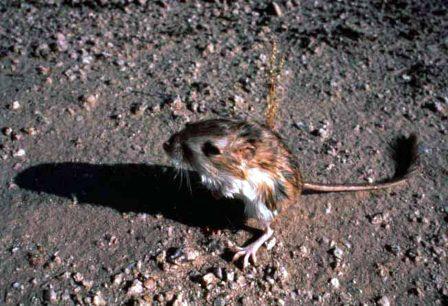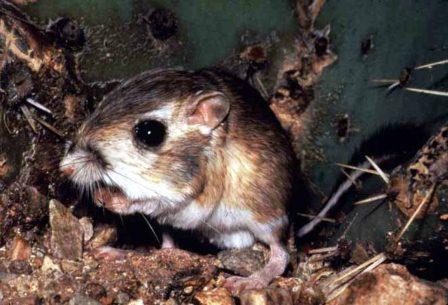The
Baja Jones
Baja Peninsula Field Guide
Kangaroo Rat

Photo: U.S.A National Park Service
QUICK FACTS
about Baja Jones’ favorite desert animal
The tail of a kangaroo rat is longer than their head and body combined. The rear legs are longer than the front legs giving their profile view a slight resemblance to a kangaroo, especially when they move fast.
Various experts state they are able to jump from
4’ up to as much
as 9’. I have seen them hop about 4 or 5 feet.
They can survive without ever drinking water.
They vary in size from a body length of 3” to 6” with the tail equally as long or longer.
They are mostly nocturnal, but also may be seen in the early evening or early morning.
They can survive without ever drinking water.
They vary in size from a body length of 3” to 6” with the tail equally as long or longer.
They are mostly nocturnal, but also may be seen in the early evening or early morning.
It is said that a kangaroo rat can hear the nearly silent flight of a low
flying owl.
Appearance & adaptation to their
environment
Kangaroo rats have a body shape that is roundish and chubby appearing. If standing
on their enlarged hind legs they might appear somewhat like a miniature kangaroo.
These enlarged and relatively strong legs, combined with a long tail that provides
balance allow them to jump long distances. This quick long jump can be just
what a kangaroo rat needs to escape the clutches of a threatening coyote or
bob cat.
Their fur color ranges from a very light tan that is almost white to a really dark brown color. Habitat and diet influence their color variations. Those around Guerrero Negro appear bright white at times, such as when caught by my headlights in the early morning just before dawn.
They do not have the menacing or sinister appearance of a city borne Norwegian rat or fruit rat, but rather appear more like a hamster with short front legs. I would describe them as cute and friendly appearing.
Their heads are somewhat large for their body size. They have storage pouches in their cheeks for carrying seeds back to their burrows. The ears on various species can appear quite different in shape and size, but on all species the ears are quite large for the size of the small animal.
The kangaroo rat is so well adapted to their harsh environment that they are my favorite desert animal. With a set of kidneys 4 times as efficient as mine, they can filter and process water from dried seeds. It is amazing to me how these tiny rodents seem to thrive in a nearly waterless environment.
Their fur color ranges from a very light tan that is almost white to a really dark brown color. Habitat and diet influence their color variations. Those around Guerrero Negro appear bright white at times, such as when caught by my headlights in the early morning just before dawn.
They do not have the menacing or sinister appearance of a city borne Norwegian rat or fruit rat, but rather appear more like a hamster with short front legs. I would describe them as cute and friendly appearing.
Their heads are somewhat large for their body size. They have storage pouches in their cheeks for carrying seeds back to their burrows. The ears on various species can appear quite different in shape and size, but on all species the ears are quite large for the size of the small animal.
The kangaroo rat is so well adapted to their harsh environment that they are my favorite desert animal. With a set of kidneys 4 times as efficient as mine, they can filter and process water from dried seeds. It is amazing to me how these tiny rodents seem to thrive in a nearly waterless environment.
Taxonomy
Unlike most animals, these desert rodents do not sweat to stay cool. Their bodies have adapted to their hot environment. To keep cool they sleep in their cool underground burrows through the heat of the day. Appearing at or near sundown for the first time each day and disappearing as the sun brings a warm orange glow to the sky.
To help maintain the moisture in their body, sleeping kangaroo rats push their tiny noses into a crook in their front legs. This keeps some of their exhaled body moisture in close proximity to their nose and reduces moisture lost through breathing.
Kangaroo rats kept in captivity have been known to develop sores on their body if they were not given loose dirt in which to take dust baths. The dust must help keep their perspiration free skin clean of harmful bacteria.
Kingdom: Animalia
Phylum: Chordata
Class: Mammalia
Order: Rodentia
Family: Heteromyidae
Genus: Dipodomys
Species: The 5 Baja Peninsula species are below
Dipodomys merriami Merriam’s Kangaroo Rat
Dipodomys agilis The agile Kangaroo rat
Dipodomys gravipes San Quintin Kangaroo Rat – endangered
Dipodomys insularis San Jose Island Kangaroo Rat – critically endangered
Dipodomys simulans The Dulzura kangaroo rat or San Diego kangaroo rat
Diet and feeding habits
Their
main food is seeds such as from mesquite and other plants. Because of this
propensity for seeds they must have food storage larders well stocked at
all times to hold them over between seeding seasons. These caches or larders
are laid out differently amongst the various species. Some species will
cache all their stash in just one or two larger caches. This makes for
easy storage and protection.
Other species spread the storage lockers throughout their localized territory. Members of these species may have 10, 20 or more small caches, which they must be able to find when needed.
Some species prefer to dig burrows in the open desert or fields, while others prefer to place their burrows amongst the roots of low lying shrubs. In the areas of Baja that I frequent, I am most familiar with the burrows being dug in and near plant root structures. This usually raises the burrow entrance a few inches above the surrounding environment and keeps the rare rainstorms from flooding out their homes.
In addition to seeds the kangaroo rats will also eat vegetation, plant leaves, flower buds, berries and even insects if really hungry. When camping along the shore somewhere I almost always smooth out some area near my tent and chair, then lay a small pile of oatmeal or rice in the center of the smooth sand. In the morning I am usually greeted by a pattern work of tiny kangaroo rat footprints.
Other species spread the storage lockers throughout their localized territory. Members of these species may have 10, 20 or more small caches, which they must be able to find when needed.
Some species prefer to dig burrows in the open desert or fields, while others prefer to place their burrows amongst the roots of low lying shrubs. In the areas of Baja that I frequent, I am most familiar with the burrows being dug in and near plant root structures. This usually raises the burrow entrance a few inches above the surrounding environment and keeps the rare rainstorms from flooding out their homes.
In addition to seeds the kangaroo rats will also eat vegetation, plant leaves, flower buds, berries and even insects if really hungry. When camping along the shore somewhere I almost always smooth out some area near my tent and chair, then lay a small pile of oatmeal or rice in the center of the smooth sand. In the morning I am usually greeted by a pattern work of tiny kangaroo rat footprints.

Photo: U.S.A. National Park Service
Reproduction
The population of kangaroo rats is in direct relationship to their food
supply. When the Baja peninsula has an abnormally rainy winter, such as
during el niño years, the population of kangaroo rats seems to double
or quadruple. This increase in population will later affect the population
of coyotes, owls and other predators.
Kangaroo rat females are known to mate with several males. Although in some species the successful male will hang around and chase other randy males away, the female will shamelessly slip away to find a second or third mate.
The gestation period is about normal for small rodents ranging from more than 20 days to less than 30 days. Average amongst the various species is approximately 25 days.
Using shed hair the female prepares a nesting chamber in her burrow. When born the youngsters live in a hair-lined nest that is comfortable and secure. The average litter size is 2 or 3, but as many as 6 may be born.
Since they are mammals, the youngsters are nursed by their mother. The babies are weaned when between 20 and 30 days old. The youngsters are relatively on their own after being weaned. They will stay with their mother in her burrow system for a period of a couple weeks up to a half a year. They reach sexual maturity at around 2 to 3 months of age.
Kangaroo rat females are known to mate with several males. Although in some species the successful male will hang around and chase other randy males away, the female will shamelessly slip away to find a second or third mate.
The gestation period is about normal for small rodents ranging from more than 20 days to less than 30 days. Average amongst the various species is approximately 25 days.
Using shed hair the female prepares a nesting chamber in her burrow. When born the youngsters live in a hair-lined nest that is comfortable and secure. The average litter size is 2 or 3, but as many as 6 may be born.
Since they are mammals, the youngsters are nursed by their mother. The babies are weaned when between 20 and 30 days old. The youngsters are relatively on their own after being weaned. They will stay with their mother in her burrow system for a period of a couple weeks up to a half a year. They reach sexual maturity at around 2 to 3 months of age.
Habitat
Kangaroo rats inhabit dry arid desert and plain-like
areas. They live near the shore, in the mountains and almost everywhere
you will travel in Baja.
They are not so common in the cities and towns.
The development of so much farmland in the San Quintin valley has had a drastic affect upon the San Quintin Kangaroo Rat population. This species is now critically endangered and could become extinct in the next 10 or 15 years.
They require well drained soil to dig their burrows. Most burrows include individual areas or rooms for sleeping, hanging out and storing of food. These are ingenious and industrious animals.
Each morning as they settle down for a day of sleep and relaxation the kangaroo rat will close the door to his burrow by filling the entrance with dirt. This helps keep the burrow cool in the heat of the day.
They are not so common in the cities and towns.
The development of so much farmland in the San Quintin valley has had a drastic affect upon the San Quintin Kangaroo Rat population. This species is now critically endangered and could become extinct in the next 10 or 15 years.
They require well drained soil to dig their burrows. Most burrows include individual areas or rooms for sleeping, hanging out and storing of food. These are ingenious and industrious animals.
Each morning as they settle down for a day of sleep and relaxation the kangaroo rat will close the door to his burrow by filling the entrance with dirt. This helps keep the burrow cool in the heat of the day.
